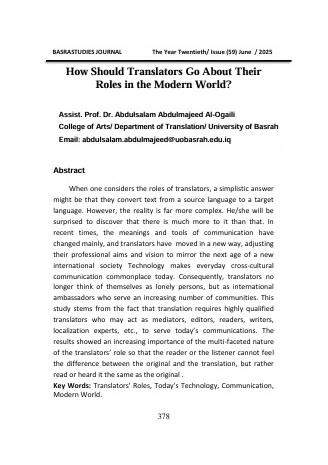How Should Translators Go About Their Roles in the Modern World?
Main Article Content
Abstract
When one considers the roles of translators, a simplistic answer might be that they convert text from a source language to a target language. However, the reality is far more complex. He/she will be surprised to discover that there is much more to it than that. In recent times, the meanings and tools of communication have changed mainly, and translators have moved in a new way, adjusting their professional aims and vision to mirror the next age of a new international society Technology makes everyday cross-cultural communication commonplace today. Consequently, translators no longer think of themselves as lonely persons, but as international ambassadors who serve an increasing number of communities. This study stems from the fact that translation requires highly qualified translators who may act as mediators, editors, readers, writers, localization experts, etc., to serve today’s communications. The results showed an increasing importance of the multi-faceted nature of the translators’ role so that the reader or the listener cannot feel the difference between the original and the translation, but rather read or heard it the same as the original .
Article Details

This work is licensed under a Creative Commons Attribution-ShareAlike 4.0 International License.
References
References
-Bedard,C.(2000)."Translation memory seeks sentence-oriented translator…".Traduire186.httpwww.terminotix.comenginfomem_1.htm.Visited 7September 2005 .
-Esselink, Bert.(2000). A Practical Guide to Localization.
Amsterdam andPhiladelphia :John Benjamins.
-Lockwood, Rose.(2000)."Machine Translation and Controlled
Authoring at caterpillar ".In Translating into success.
Cutting-edge strategies for going multilingual in a global age.Robert C. Sprung (ed), AmsterdamPhiladelphi: John Benjamins. 187-202.
-Megal,Fabrizio.(2004).Diritto d'autore del traduttore. Napoli:
Editoriale Scientifica.
-Munday – Introducing Translation Studies, London and New York, Routledge, 2001 [4] Douglas 8. Robinson - Becoming a Translator. An Introduction to the Theory and Practice of Translation, Second Edition, London and New York, Routledge, 2003.
-Mullamaa, K. and Pineiro, O.(2006) Is Localization Just Technology. Spain: University of Rovira and Virgili. Cited in Translation and Technology and its Teaching.(2006) Tarragona: Spain.
-Newmark, P.(1988) A Textbook of Translation.UK: Shanghai Foreign Language Education Press
-Newmark, P.(2005) Studies in English.USA: Masaryk University. Retrieved from: www.tradovision.com/wp/read.php?id
-Rodica, Teodora, Biriş, Denglisch – eine Umgangssprache? , Studii de Ştiinţă şi Cultură, (Science and Culture Studies) “Vasile Goldiş” University Press Arad, December, 2011, ISSN 1841-1401.
-Rodica Dumitriu - The Cultural Turn in Translation Studies, Iaşi, Institutul European, 2006 [3] Jeremy
-Schulte,R.(1985)Editorial: Translation and Reading. UK: Taylor & Francis Group. Cite in Journal Translation Review.Volume18,1985-.Issue1.
-Tonkin and Frank (2009) The Translator as Cultural Mediator. USA:.University of Hartford.
-Victoria, G (2005) Translation Techniques. Canada. Retrieved
